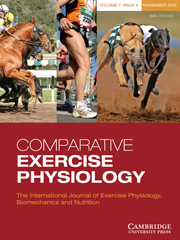Article contents
Dressage training affects temporal variables in transitions between trot and halt
Published online by Cambridge University Press: 19 October 2009
Abstract
The gaits of the dressage horse have been described, but less information is available regarding the transitions between gaits. The objective was to describe and compare temporal variables during transitions from trot to halt (TH) and halt to trot (HT) in horses competing in different levels of dressage competitions. The experimental hypothesis was that a higher level of training is associated with the ability to make more direct transitions with fewer non-trot steps. Video recordings of TH and HT transitions were made during novice (n = 15 horses), medium (n = 15 horses) and advanced (n = 15 horses) dressage competitions and were analysed to determine the timing of footfalls and lift-offs. Duty factors, diagonal dissociations and suspension durations were calculated for eight diagonal steps preceding and following the halt. The steps were classified as trot or non-trot based on diagonal synchrony of the footfalls. Statistical analysis using a general linear model ANOVA with Tukey B post hoc tests indicated that advanced horses changed their limb coordination patterns more abruptly, and that they maintained positive diagonal dissociation and a suspension phase in the steps in closer proximity to the halt than the novice horses. There was no preference between left/right and fore/hind limbs in the order of limb placements in the TH transition. The first limb to move off from the halt was always a forelimb, with a significant preference for the right forelimb in the advanced horses.
- Type
- Research Paper
- Information
- Copyright
- Copyright © Cambridge University Press 2009
References
- 6
- Cited by


